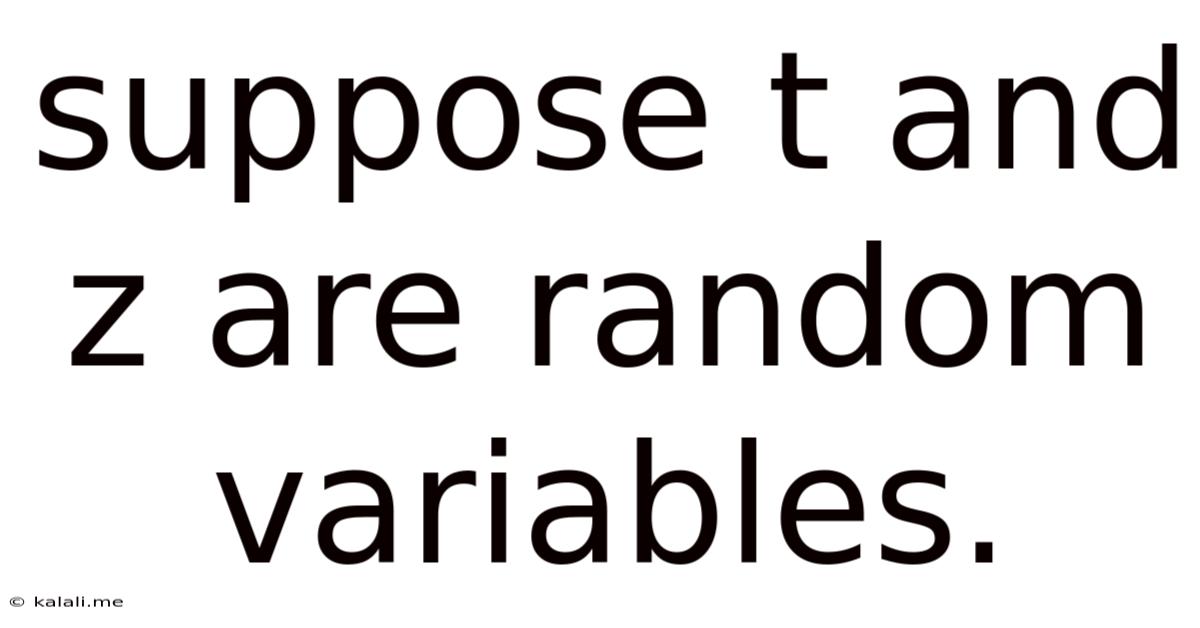Suppose T And Z Are Random Variables.
Kalali
Jun 11, 2025 · 3 min read

Table of Contents
Exploring the Relationship Between Random Variables T and Z
This article delves into the fascinating world of probability and statistics, specifically examining the relationship between two random variables, T and Z. We'll explore various aspects of their interaction, including joint probability distributions, conditional probabilities, and covariance, providing a comprehensive overview suitable for both beginners and those with a foundational understanding of the subject. Understanding the relationship between random variables is crucial in numerous fields, from finance and engineering to machine learning and data science.
Understanding Random Variables
Before diving into the specifics of T and Z, let's briefly recap what random variables are. A random variable is a variable whose value is a numerical outcome of a random phenomenon. Essentially, it's a way to assign numerical values to the possible outcomes of an experiment. These values can be discrete (taking on only specific, separate values like the number of heads in three coin flips) or continuous (taking on any value within a given range, like the height of a person).
Joint Probability Distribution
When dealing with two random variables, T and Z, a crucial concept is their joint probability distribution. This distribution describes the probability that T takes on a specific value and Z simultaneously takes on another specific value. This is often represented as P(T=t, Z=z) for discrete variables or f<sub>T,Z</sub>(t, z) for continuous variables (where f represents the probability density function). The joint distribution encapsulates the complete relationship between the two variables.
Marginal Probability Distributions
From the joint distribution, we can derive the marginal probability distributions of T and Z individually. The marginal distribution of T, for example, represents the probability distribution of T regardless of the value of Z. It's obtained by summing (for discrete variables) or integrating (for continuous variables) the joint distribution over all possible values of Z. Similarly, we can find the marginal distribution of Z.
Conditional Probability Distributions
Another important aspect is the conditional probability distribution. This describes the probability distribution of one variable, say T, given a specific value of the other variable, Z. This is denoted as P(T=t | Z=z) for discrete variables or f<sub>T|Z</sub>(t|z) for continuous variables. Conditional probabilities are crucial for understanding how the value of one variable influences the probability distribution of the other. They form the basis for concepts like Bayesian inference.
Independence of Random Variables
Two random variables T and Z are considered independent if the occurrence of one event does not affect the probability of the other event. Mathematically, this means that the joint probability distribution is equal to the product of the marginal distributions: P(T=t, Z=z) = P(T=t)P(Z=z) for discrete variables, and similarly for continuous variables.
Covariance and Correlation
The covariance measures the linear relationship between T and Z. A positive covariance indicates a tendency for T and Z to move in the same direction, while a negative covariance suggests they move in opposite directions. A covariance of zero doesn't necessarily imply independence, only the absence of a linear relationship. The correlation coefficient, which is a standardized version of the covariance, provides a more interpretable measure of the linear relationship, ranging from -1 (perfect negative correlation) to +1 (perfect positive correlation).
Examples of Relationships
Numerous real-world scenarios illustrate the relationship between random variables. For instance:
- Height and Weight: Height and weight are likely to show a positive correlation. Taller individuals tend to weigh more.
- Temperature and Ice Cream Sales: Temperature and ice cream sales will probably exhibit a positive correlation. Higher temperatures lead to increased ice cream sales.
- Stock Prices: The prices of different stocks might exhibit correlation, indicating that their movements are related.
Conclusion
Understanding the relationship between random variables, T and Z, involves analyzing their joint probability distribution, marginal distributions, conditional probabilities, independence, covariance, and correlation. These concepts are fundamental to statistical analysis and have widespread applications in various disciplines. Further exploration into specific types of distributions, such as the bivariate normal distribution, can provide even deeper insights into the intricacies of these relationships.
Latest Posts
Latest Posts
-
Imagery Or Figurative Language From Romeo And Juliet
Jul 02, 2025
-
What Is A Quarter Of A Million
Jul 02, 2025
-
Which Of The Following Is True Concerning A Dao
Jul 02, 2025
-
How Long Can Catfish Live Out Of Water
Jul 02, 2025
-
Is Kanye West Related To Cornel West
Jul 02, 2025
Related Post
Thank you for visiting our website which covers about Suppose T And Z Are Random Variables. . We hope the information provided has been useful to you. Feel free to contact us if you have any questions or need further assistance. See you next time and don't miss to bookmark.